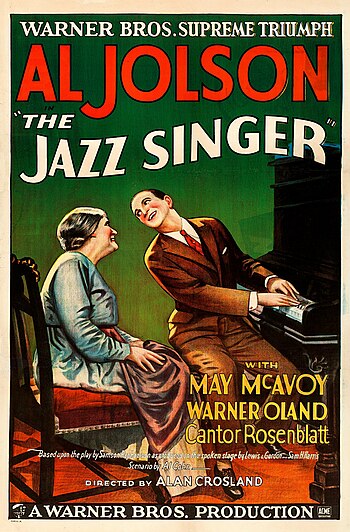The Jazz Singer

"You ain't heard nothing yet!" |
The 1927 film The Jazz Singer tells the story of Jakie Rabinowitz (played by Al Jolson), the son of a Jewish cantor, who declines to follow in his father's footsteps. Instead, he dissembles his Jewish identity while trying to make it in the world of popular music. Just as Jakie is about to hit the big time, his father falls ill, forcing Jakie to choose between his family and his show-biz dreams.
The Jazz Singer, despite its reputation as the first "talkie," is fundamentally a silent film, with an atmospheric musical backdrop, no sound effects, and dialogue on title cards. It does, however, have several recorded songs which are lip-synced (with variable success), and during the filming/recording of one of these songs, Jolson ad-libbed a spoken intro: "Wait a minute, wait a minute, you ain't heard nothin' yet! Wait a minute, I tell ya! You ain't heard nothin'!" (Additionally, the film has one short synchronized dialogue scene where Jolson talks to his mother.)
Audiences at the time heard something in that.
Experiments in recorded film sound were nothing new; as far back as 1894, an Edison film of a violin player was paired with a recording of the instrument. In 1926, the Warner Bros. film Don Juan was released with a prerecorded, instrumental soundtrack, eliminating the need for live accompaniment. Sunrise, a critically adored experimental melodrama released the same year as The Jazz Singer featured a line or two of background chatter as part of the soundtrack. What The Jazz Singer brought to the table was an ambitious use of synchronization. Even that, if confined to the songs, might have remained a sterile gimmick. But speech -- that was something else. The first "Full-talkie" picture was The Lights of New York, a gangster film released in 1928.
Oh, yeah -- the Blackface scene. The redeeming element may be that the song -- "My Mammy" -- reflects Jakie's reconciliation with his own mother; in a way, Jakie is identifying very deeply with the stereotyped "darkie" character he portrays. It was also 1927. It was very common in old cartoons of the 1930s to reference this scene via Blackface gags (i.e. smoke or ash being blown onto the victim's face, which somehow makes them want to shout "Mammy!").
There were two remakes of this film:
- 1956, starring Danny Thomas. This version made one of the Medved's Worst Film compilations. Anyone who has seen it and is willing to admit it should write in.
- 1980. Neil Diamond is The Jazz Singer. This version is very much a sound film, and has its own page.
- Billy Elliot Plot: Sort of, if you consider singing to be "feminine" and being a cantor to be "manly."
- Blackface: One of the most famous examples in film.
- Dies Wide Open: Cantor Rabinowitz, oddly enough, closes his eyes first, slumps, and then opens them again after he dies.
- I Have No Son
- Redemption Equals Death: Inverted; Cantor Rabinowitz dies after Jack returns to the synagogue and sings, thus earning his father's forgiveness.
- "Well Done, Son" Guy: All the Jazz Singer wants is his father's approval.
- The 1936 Merrie Melodies cartoon I Love to Singa, directed by Tex Avery, featuring fledgling jazz singer "Owl Jolson" rebelling against his family of traditionalist musicians.
- An SCTV sketch, guest-starring Al Jarreau, which reverses the plot in that the father expects the son to be a jazz singer like himself but the son instead becomes a cantor.
- The Simpsons episode Like Father, Like Clown, guest-starring the voice of Jackie Mason as Krusty's estranged father Rabbi Hyman Krustovsky.
- Mason himself is to some extent a Real Life instance of The Jazz Singer; under pressure from his father he received rabbinic ordination as his brothers did, but he subsequently chose to become a comedian.